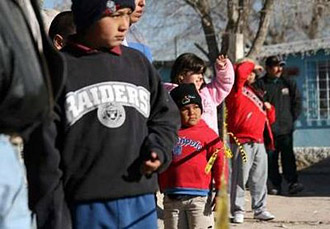
|  |  |  News Around the Republic of Mexico News Around the Republic of Mexico  
Slayings in Tijuana Down from 2008
 Sandra Dibble - San Diego Union-Tribune Sandra Dibble - San Diego Union-Tribune
go to original
January 01, 2010


| | Children gather near a crime scene in a poor neighborhood on the outskirts of Ciudad Juarez, Mexico January 1, 2010. (Reuters/Alejandro Bringas) |  |
As 2009 closed, violence once again claimed lives in Tijuana this week, including that of a state auto theft investigator found beheaded hours after he was abducted from his home, two men shot to death outside a tire store and a man killed at a taco shop.

Despite the surge in violence in the year’s final days, Tijuana’s 657 killings in 2009 represent a 20 percent drop from 2008, when Tijuana registered a record 844 homicides.

Still, authorities struggled to explain a renewed increase in killings in December. With 124 murders, it was the year’s most violent month and saw the resurgence of such gangland practices as decapitations and cryptic messages left at crime scenes.

“The great majority of deaths can be attributed to organized crime,” said Fermin Gomez, Baja California’s deputy attorney general. “We have seen clearly that there is an ongoing struggle between two criminal groups that are fighting for control of the plaza.”

The struggle dates to April 2008. It pits Fernando Sánchez Arellano, a nephew of the Arellano Félix brothers who once dominated the region, against Teodoro García Simental, a former top lieutenant who broke away from the organization.

Some say the violence has followed a cyclic pattern, rising and falling as the organizations fight each other and Mexican law enforcement and alternately move through strong and weak phases. Others say the trends point to fragile pacts between the rival groups and the inevitable breakdown of those pacts.

“I don’t think anyone knows the answers, in the end, of what’s going on between the cartels,” said David Shirk, an associate professor at the University of San Diego who studies drug-trafficking organizations. “Despite important successes for the Calderon administration, the outlook looks pretty bleak for getting things under control.”

The rates of drug-related violence across Mexico first spiked in 2008 as President Felipe Calderón led an unprecedented push against drug cartels, putting the Mexican military at the forefront.

Drug-related killings hit 5,200 across Mexico in 2008, according to a tally by the Mexico City newspaper Reforma. In 2009, they rose even higher, with 6,500 victims registered through December 25, Reforma’s figures show.

Baja California has run counter to the national trend, dropping by about half, from 617 drug-related killings in 2008 to 316 through Dec. 25 of this year, according to Reforma. Gomez, the deputy state attorney general, estimates that about half of Tijuana’s killings in 2009 were connected to organized crime, reaching close to 330.

Gomez said 31 of this year’s victims were Tijuana police officers. Some have had ties to organized crime, but others were killed in the line of duty.

Among the most recent victims was Marco Antonio de la Luz Arellano, 32, a state police agent assigned to the auto theft unit. Abducted from his home on Tuesday, his decapitated body was found Wednesday morning in a residential area with a message attached. Gomez said investigators are looking into his possible ties to organized crime.

While the majority of recent victims are believed to be low-ranking members of the local drug trade, the violence has also claimed the lives of bystanders. Yajaira Mota Orozco, a 23-year-old woman from San Diego, was shot on Dec. 15 when gunmen assaulted a restaurant in the city. And Jamine Torres, a 16-year-old student, was struck by a stray bullet Oct. 27 as she was helping her mother set up a food stand.

Baja California is a key transit point for illicit drugs being smuggled to the United States and has developed its own drug demand problem. Gov. José Guadalupe Osuna Millán said he opposes legalization of any now-illicit drugs and has repeatedly insisted that the ultimate solution is reducing demand in the United States and Mexico.

For Osuna Millán, 2009 marked a year of unprecedented efforts against criminal groups operating in the state. He touts Rosarito Beach as a success story, saying crime rates there have dropped dramatically since 2008.

In an interview this week, Osuna Millán said the state must keep following its current course: “I would continue with the frontal battle, with the participation of the military, with the purging of the police forces that for so many years have been infiltrated” by organized crime.”

Others say the recent spike in homicides is worrisome.

“I think for 2010 we need to rethink the strategy,” said Roberto Quijano Sosa, head of the business group, Coparmex. Coordination among police agencies has improved, and “we recognize the seizures, and important numbers of arrests,” he said. “More than ever, we need to develop better intelligence.”
|

 |
|  |



